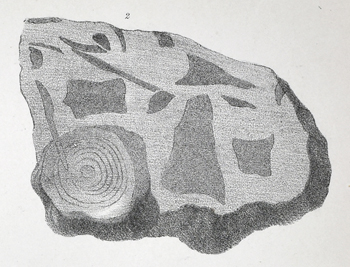Coprolites, recognised 1824

|
| Ichthyosaur coprolites from Lyme Regis, from W Buckland, "On the discovery of coprolites or fossil faeces in the Lias at Lyme Regis, and in other formations", Transactions of the Geological Society, London, S2-3 (1829). GSL Library Collections. |
The second subject covered by William Buckland’s paper were the spiralled, pebble-like forms which the local fossil collectors in Lyme referred to as bezoar stones after the concretions found in the gastronintestinal tracts of animals such as goats that were once used in traditional medical treatments. However embedded in the Lyme bezoar stones were scale and bone fragments of fish. Mary Anning had recognised what these were from as early as 1824 frequently finding them within the abdomens of the ichthyosaurs she found. As Buckland would write:
 "The author concludes from an extensive series of specimens, that the fossils, locally called Bezoar stones, which abound at Lyme, in the same beds of lias with the bones of Ichthyosaurus, are the faeces of that animal." From W Buckland, "On the discovery of a new species of Pterodactyle; and also of Faeces of the Ichthyosaurus; and of a black substance resembling Sepia in the Lias at Lyme Regis", Proceedings of the Geological Society of London, vol 1 (1829).
"The author concludes from an extensive series of specimens, that the fossils, locally called Bezoar stones, which abound at Lyme, in the same beds of lias with the bones of Ichthyosaurus, are the faeces of that animal." From W Buckland, "On the discovery of a new species of Pterodactyle; and also of Faeces of the Ichthyosaurus; and of a black substance resembling Sepia in the Lias at Lyme Regis", Proceedings of the Geological Society of London, vol 1 (1829).
By the formal publication of the paper in the Society's 'Transactions', Buckland had named them ‘coprolites’ [Greek - ‘dung stone’]. As further evidence of their identification, Buckland's paper cited Anning's observations and experience:
“...Miss Anning informs me that since her attention has been directed to these bodies, she has found them within the ribs or near the pelvis of almost every perfect skeleton of Ichthyosaurus which she has discovered. She further informs me, that whereas in the entire thickness of the lias formation there are certain strata that abound in bones, whilst in others they are comparatively rare; so also the so-called Bezoars are most abundant in those parts of the formation in which the bones of Ichthyosauri and Plesiosauri are most numerous.” From W Buckland, "On the discovery of coprolites or fossil faeces in the Lias at Lyme Regis, and in other formations", Transactions of the Geological Society, London, S2-3(1829).

|
|

|
| Coprolites with undigested scales, teeth and bones from fish and the remains of the horny rings of the suckers of cephalopods (left). The coprolite on the right contains an ichthyosaur vertebra of around an inch in diameter indicating that the creature was around 4 feet in length before it was eaten by a larger species . Both images from W Buckland, "On the discovery of coprolites or fossil faeces in the Lias at Lyme Regis, and in other formations", Transactions of the Geological Society, London, Series S2-3 (1829). GSL Library collections. |
The realisation of what these forms were, led Buckland to investigate other fossil collections and successfully find more coprolites, some of which had been misidentified as fossil pine cones.
Coprolites are important as they allow scientists to reconstruct the likely size and diet (and hence the environment) of long extinct creatures.
<<Back
Next: Fossil sepia>>